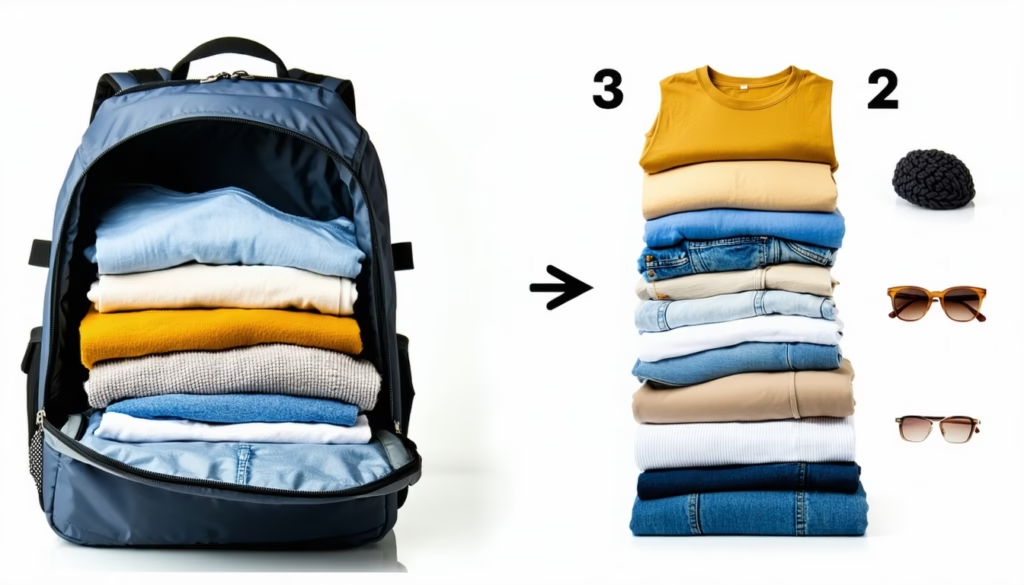Step-By-Step Guide To Layering Clothes Efficiently When Packing

You’ve probably shoved, folded, and squeezed your way through packing more times than you can count. Ever felt like your backpack’s bursting at the seams before you even zip it up? In this step-by-step guide to layering clothes efficiently when packing, you’ll learn how to stack outfits smartly so you maximize every inch of space, minimize wrinkles, and keep your gear organized. By the end, you’ll breeze through prep, fill your bag like a pro, and still have room left for souvenirs.
You don’t need fancy gadgets to master layering—just a few tips, some simple tools (think packing cubes or compression bags), and a system that treats your backpack like a Tetris board. Ready to dive in? Let’s walk through this step by step.
Step 1: Lay Out Your Clothes
Clear Your Space
First, find a clean, flat surface—your bed or a cleared floor works best. Spread out a protective sheet or large towel if you’re worried about dirt. Having everything visible helps you spot missing items and keeps your layering process smooth.
Identify Layer Types
Group garments into three categories—base, mid, and outer layers. Here’s a quick reference:
| Layer Type | Purpose | Examples |
|---|---|---|
| Base Layer | Moisture wicking, comfort | T-shirts, underwear, leggings |
| Mid Layer | Insulation | Sweaters, flannel shirts |
| Outer Layer | Weather protection, style | Jackets, rain shells |
Knowing these groups up front stops you from randomly tossing tees next to bulky fleeces. It’s like sorting puzzle pieces before assembly.
Step 2: Sort And Bundle Items
Create Small Bundles
Take 2–3 items that share a function—like two T-shirts plus a pair of leggings—and roll them into a tight bundle. Rolling saves space and reduces wrinkles. Keep bundles uniform so they stack neatly.
Use Packing Cubes
If you’ve got packing cubes on hand, assign one cube per layer category. Slide your base-layer bundles into one cube, mid layers in another, and outerwear in the last. For tips on choosing the right cubes, check our guide on how to use packing cubes for ultimate luggage organization. You’ll stay organized, and unpacking becomes a breeze.
Step 3: Pack Base Layers
Slide Into Bottom
Place your base-layer bundles at the bottom of your backpack. Their compact shape creates a stable foundation. Line them up flat or upright, depending on the shape of your bag.
Smooth Out Wrinkles
After sliding bundles in, give the top surface a gentle pat. T-shirts and underwear compress easily, so press down to even out bumps. A smooth base supports everything above it.
Step 4: Add Mid Layers
Position Evenly
Next, arrange your mid-layer cubes or bundles directly on the base. Distribute weight evenly from side to side. This balance prevents your bag from leaning or sagging.
Fold Lightly
If you skipped cubes and have sweaters folded, use a loose fold (don’t crease sharply). Place folded mid layers so their folds run perpendicular to the pack’s length—this cuts down on prominent wrinkle lines.
Step 5: Tuck Outer Layers
Arrange Like A Shield
Outer layers tend to be bulkier but more flexible. Lay jackets and rain shells over mid layers like you’re draping a shield. This extra cover keeps rain gear accessible and cushioned.
Keep Accessible
Think about quick-grab items such as a windbreaker or fleece you might need at a moment’s notice. Tuck these into a top pocket or side compartment. No need to dig through everything when a cool breeze hits.
Step 6: Fill Gaps With Accessories
Use Socks And Underwear
Stuff socks into shoe cavities (if you’re carrying a pair) and wedge rolled underwear into nooks. These soft accessories are perfect for filling narrow gaps without bulking up.
Stash Small Items
Pens, chargers, and belts are gap-fillers too. Keep them organized in a ziplock or slim pouch. For more ideas on storing undergarments, see the best way to pack underwear and socks in small luggage.
Step 7: Final Seal And Compress
Zip Up And Press
Once your layers are in place, zip your backpack closed. Give the top a firm push to settle loose bits and double-check that nothing is sticking out.
Consider Compression Bags
If you still need extra space, slip mid- and outer-layer bundles into a small compression bag. Squeeze out excess air for up to 30 percent more room. Learn more about this trick in our article on how to use vacuum bags for efficient space-saving packing.
Step 8: Adjust And Review
Test Your Backpack
Put the pack on and walk around a bit. Check for pressure points or bulging sections. Your bag should feel balanced and snug—if it shifts too much, you might need to redistribute items.
Shift As Needed
If you notice a heavy side or a floppy bottom, swap bundles until the weight feels centered. A well-packed backpack should sit close to your back (but not too tight) and allow free movement.
FAQs
How Do I Prevent Wrinkles When Layering Clothes?
To cut wrinkles, roll base layers instead of folding, use loose folds for mid layers, and place bulkier items on top. Press gently after packing to smooth out minor creases.
Can I Layer Damp Clothes In My Backpack?
It’s best to air-dry damp items or seal them in a waterproof pouch before packing. Moisture can cause mildew or transfer odors to dry garments.
Are Packing Cubes Necessary For This Method?
Packing cubes aren’t mandatory but they boost organization and make it easier to pull out specific layers without disturbing everything else. They’re a small investment for big convenience.
What’s The Best Way To Keep Jacket Accessible?
Store your lightest outer layer in an easy-reach pocket or at the top of your main compartment so you don’t have to unpack multiple bundles when the weather changes.
How Do I Fit Bulky Sweaters Without Wasting Space?
Fold sweaters loosely and lay them over mid layers like a blanket. Press gently to compact them, or use a compression bag to reduce their volume by up to half.
Conclusion
Layering clothes efficiently when packing transforms your backpack from an overstuffed struggle into a streamlined carry-on companion. You’ve learned how to categorize garments, roll and fold for minimal wrinkles, and use cubes or bags to maximize every cubic inch. Give this system a try on your next trip—you might be surprised at just how much you can fit without a single crease.
With your layers in place, you’ll breeze through airport lines, swap outfits on the go, and still have room for that extra T-shirt you love. Safe travels, and happy packing!


